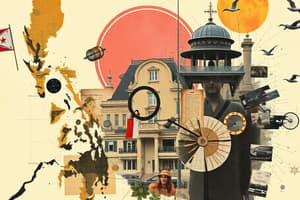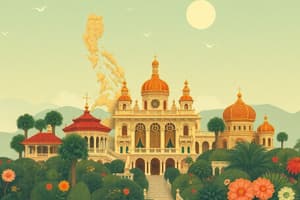Podcast
Questions and Answers
Who discovered the Philippines in 1521?
Who discovered the Philippines in 1521?
- Ferdinand Marcos, Jr.
- Ferdinand Magellan (correct)
- A Portuguese explorer other than Magellan
- Ferdinand Marcos
What type of economy does the Philippines have?
What type of economy does the Philippines have?
- Purely agricultural
- Service-based economy
- Industrial economy
- Mixed economy (correct)
When did the Philippines gain its independence from the United States?
When did the Philippines gain its independence from the United States?
- 1898
- July 4, 1946 (correct)
- 2024
- 1935
What is the national sport of the Philippines?
What is the national sport of the Philippines?
Who is the current president of the Philippines, as of 2024?
Who is the current president of the Philippines, as of 2024?
Flashcards are hidden until you start studying
Study Notes
The Philippines
Land
The Philippines is an archipelago in Southeast Asia, located between the Pacific Ocean and the South China Sea. It consists of more than 7,000 islands and islets, making it the second-largest archipelago in the world by number of islands, with only Indonesia having more. The islands spread out in the shape of a triangle, with the Batan Islands to the north of Luzon forming its apex, and the southern base outlining the Sulu Archipelago and the island of Mindanao.
The land area of the Philippines is approximately 115,831 square miles (300,000 square kilometers), making it the 12th largest country in the world. The largest islands are Luzon, Mindanao, and Palawan, which together account for about two-thirds of the total land area.
Climate
The climate in the Philippines is tropical and strongly monsoonal, with two distinct seasons: the dry season from November to April and the wet season from May to October. Temperatures typically range between 75°F (24°C) and 89°F (32°C), with higher temperatures in the southern islands and lower temperatures in the northern regions.
People
The population of the Philippines is estimated to be around 116,628,000 as of 2024. The majority of the population is of Malay descent, with significant Spanish, Chinese, and American ancestry.
People & Culture
Filipinos are known for their diverse cultural heritage, which includes influences from Spain, China, the United States, and indigenous cultures. Spanish is the official language, but English is widely spoken, especially in education and business.
History
The Philippines were first discovered by Portuguese explorer Ferdinand Magellan in 1521. The islands were later colonized by Spain in the 16th century and remained under Spanish rule for over 300 years. In 1898, the Philippines were granted to the United States after the Spanish-American War. In 1935, the Philippines became a self-governing commonwealth, but its independence was delayed by World War II and the Japanese occupation. After the war, the Philippines regained its independence on July 4, 1946.
Government & Society
The Philippines is a unitary republic with a president as both the head of state and government. The president is elected by popular vote and serves a six-year term. The country has a bicameral legislature, with a Senate and a House of Representatives.
Economy
The Philippines has a mixed economy, with agriculture, manufacturing, and services being the main sectors. The country is rich in natural resources, including minerals, timber, and fish.
Cultural Life
Filipinos are known for their vibrant culture, which includes music, dance, and traditional festivals. The national sport is basketball, and the country has produced several professional players.
Recent News and Events
In 2024, Ferdinand ("Bongbong") Marcos, Jr., son of former President Ferdinand Marcos, was elected as the new president of the Philippines, continuing the political legacy of his family. The country is also experiencing a resurgence in tourism, with popular destinations such as Boracay, Palawan, and Siargao attracting visitors from around the world.
Despite these positive developments, the Philippines faces challenges such as poverty, corruption, and environmental degradation. The government is working to address these issues and improve the overall well-being of its citizens.
Studying That Suits You
Use AI to generate personalized quizzes and flashcards to suit your learning preferences.



